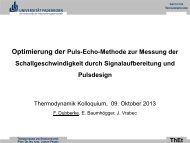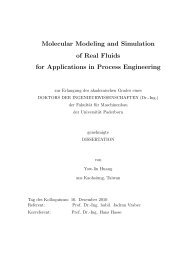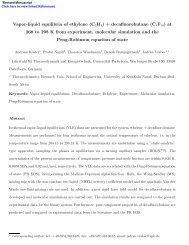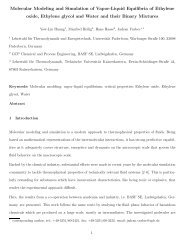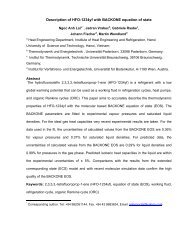ms2: A Molecular Simulation Tool for Thermodynamic Properties
ms2: A Molecular Simulation Tool for Thermodynamic Properties
ms2: A Molecular Simulation Tool for Thermodynamic Properties
You also want an ePaper? Increase the reach of your titles
YUMPU automatically turns print PDFs into web optimized ePapers that Google loves.
Programming (OOP). It should be mentioned that OOP holds challenges regarding efficiency. Distributing the<br />
data between objects can lead to data fragmentation and indirections can occur, leading to a negative impact on<br />
the per<strong>for</strong>mance. One objective was to introduce OOP concepts, while still maintaining efficiency, cf. section 6.<br />
Fortran issues.<br />
Fortran90 modules are a further development of Fortran77 common blocks. A module may not only contain data,<br />
but also define subroutines and user derived data types. Due to the fact that module data and associated module<br />
subroutines implement singletons from the start, grouping module-defined user derived data types and associated<br />
functions also allows an OOP-like programming style. A small example will demonstrate this. The module<br />
ms simulation, defined in the file ms simulation.F90, contains the type T<strong>Simulation</strong> as well as the subroutines<br />
• T<strong>Simulation</strong> Construct ( this )<br />
• T<strong>Simulation</strong> Destruct ( this )<br />
• T<strong>Simulation</strong> RunSteps ( this , StepStart , StepEnd )<br />
among others. The strict naming convention helps avoiding clashes in name space. All the subroutines above<br />
receive a reference to an instance of T<strong>Simulation</strong> through the first parameter, named this, and they serve as<br />
(default) constructor, destructor or ordinary member function, respectively. In the following, constructs likethis<br />
will be referred to as a class. <strong>ms2</strong> does not strictly follow an OOP approach, because all data elements can be<br />
accessed directly, there<strong>for</strong>e there is no in<strong>for</strong>mation hiding through data encapsulation.<br />
Class structure.<br />
In order to keep the class hierarchy flat, <strong>ms2</strong> does not make use of inheritance and hence polymorphism. E.g.<br />
the module <strong>ms2</strong> site contains the classes TSiteLJ126, TSiteCharge, TSiteDipole and TSiteQuadrupole, which<br />
have data and functionalities in common, but are not derived from a common class. The class structure and the<br />
relations between the classes are organized in six levels, as depicted in Figure 4. Every class is located on a<br />
certain level and hence has data and modules relevant to its level. The six levels are intuitive:<br />
1. Global – all data and functions of global use are handled. Scope: whole code<br />
2. <strong>Simulation</strong> – setup and control of the simulation. Scope: simulation framework<br />
3. Ensemble – the required ensemble is set up and initialized. Scope: molecular ensemble<br />
4. Component – data and functions dealing with all molecules of a given molecule type. Scope: one molecule<br />
species<br />
5. Molecule – data regarding the basic structure of a molecule. Scope: one molecule<br />
6. Site – position of sites with respect to a molecule. Scope: one site of one molecule<br />
All subroutines on every level are task specific and implemented as modules. Depending on the simulation setup,<br />
e.g. MD/MC or ensemble, the appropriate modules are engaged individually during simulation. The modules of<br />
<strong>ms2</strong> can coarsely be divided into following tasks:<br />
17



